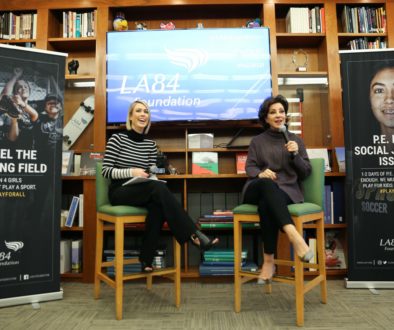SL Interview: George Dohrmann’s New Book on AAU Youth Basketball
A few weeks before Christmas in 2000, while working on a feature story about Southern California high school basketball phenom Tyson Chandler, Sports Illustrated staff writer George Dohrmann interviewed Joe Keller, Chandler’s former youth coach. After the publication of the article, Dohrmann stayed in contact with Keller, who was in the process of forming a basketball team of 10-year-olds in the San Bernardino area. Keller believed that the star of the team, Demetrius Walker, would develop into a surefire lock for the NBA.
Dohrmann followed the fortunes of Keller, Walker and his teammates for the next eight years, or until the boys were high school seniors. As they navigated the labyrinthine world of AAU basketball, Dohrmann was eye witness to a grassroots sub-culture populated by sneaker company marketing reps, college and high-school coaches, sports agents, media titans and the youths’ own parents.
Dohrmann notes that the AAU system has produced “nearly every great American-born basketball player of the last ten years – from Kevin Garnett to Kobe Bryant to Tracy McGrady to LeBron James.” And yet, argues Dohrmann in his exhaustively reported book, “Play Their Hearts Out: A Coach, His Star Recruit, and the Youth Basketball Machine” (Ballantine Books; Amazon), the vaunted AAU basketball machine has also degenerated into a sleazy cesspool of greed and waste.
This groundbreaking, enlightening and passionate book should serve as a wake-up call for those parents, coaches and administrators who profess to care about youth sports. Commented Los Angeles Times columnist Bill Dwyre about “Play Their Hearts Out”: “A good book will leave you laughing or crying. I just read one that left me wanting to take a shower.”
Dohrmann first reported on youth basketball in the mid-1990s for the Los Angeles Times, where Dwyre was his editor. Dohrmann went on to win the 2000 Pulitzer Prize for beat reporting while working at the St. Paul Pioneer Press. His investigative story unearthed academic fraud within the men’s basketball program at the University of Minnesota. He has worked at Sports Illustrated since 2000.
SportsLetter spoke to Dohrmann from his home in San Francisco.
–- David Davis
SportsLetter: You began following Demetrius Walker and his teammates when they were 10 years old. What got you interested in the subject of youth basketball?
George Dohrmann: I’d written a little about it when I worked for the Los Angeles Times and then for Sports Illustrated and knew it was this interesting sub-culture that was unexamined and certainly unregulated. One of the first stories I did for Sports Illustrated was about [former Compton Dominguez High School center] Tyson Chandler, and during the course of reporting that I met Joe Keller. So, it was this confluence of me knowing that that world was out there, ripe with possibility, and meeting this guy, Joe Keller, at the beginning of his journey, as he started to form and then coach a new team.
SL: You followed Keller’s team for eight years. When did it occur to you that, to capture the full arc of the kids’ youth sports careers, you had to keep reporting for so long?
GD: Right from the beginning, I told Joe Keller that I wanted to follow the boys from the beginning of their grassroots experience – meaning, when they were 10 – until the end, which was the summer between their junior and senior years in high school. That was always the goal. At different times I thought about aborting it or cutting it short. I talked with Joe about that. But I realized that, for readers to understand the damage that was done to the boys and how they were scarred and how the machine works, I needed to stick with them until the end and see the final outcome.
SL: Demetrius Walker was clearly the star of the team. How would you describe his game and his personality when you first met him?
GD: He was just this fantastic kid. The opening scene in the book with Demetrius is him helping out a girl who just missed a jump shot. That was Demetrius. He was this selfless kid. He was an old soul, forced to grow up a little faster than he should have, kind of a latchkey kid. At the same time, he was just a kid. He loved to laugh. He had that innocence that you love to see with a 10-year-old. As a player, he was just fantastic. It wasn’t just that he was tall; there were boys that were taller than him. Athletically, the speed and agility that he had was head and shoulders above everybody else that he played against.
SL: In 2005, Walker was featured on the cover of Sports Illustrated as an eighth-grader, and the headline of the story read “The Next LeBron?” How did that article change him, both as a player and as a person?
GD: The ramifications of that article were huge, but it wasn’t the article that changed him. It was what happened afterwards, including all the attention and the fawning that people gave him. Not only did it take away that selflessness that he had, but it put this target on him at an early age. He wasn’t a good enough player, because of his coach’s deficiency in not teaching him the fundamentals of the game, to deal with all the challengers that came at him after that article came out.
SL: How did you feel about that article? Was it valid journalism to feature him at that young age?
GD: I think this is an interesting question. The author of the article, Karl Taro Greenfeld, wasn’t a sportswriter. His idea behind the story was to ask the question, “Should we be focusing our attention on these young boys?” But by doing the story, he focused attention on these young boys. So, it was this Catch-22. Unfortunately for Karl and for Sports Illustrated, the nuance of the story and the big questions that it asked got lost. He quoted Tracy McGrady as saying “This is not right,” but all people took from the story was, “Sports Illustrated called Demetrius Walker the next LeBron.”
At the time, I hoped that Joe Keller and Kisha Houston, Demetrius’ mom, would not agree to the article. I thought the best move was for them to say no. But as a journalist, I had to step aside and let it play out.
SL: In a general sense, how would you describe the role of the media in the coverage of youth sports?
GD: I think there are reporters who do a great job and who are responsible. And then there are these vultures – people who run scouting services and publish recruiting newsletters – that call themselves media members. But, really, they’re just profiteers, people who leverage the hype and the excitement around these young stars to help sell subscriptions and other things. The people who rate fourth- and fifth-graders and hover around these kids, they’re so-called members of the media, but they are truly some of the most horrible individuals in the game.
SL: It’s clear that you enjoyed a close relationship with some of the players. Did you feel comfortable giving the boys advice about their careers and the coaching?
GD: No, I purposely kept my mouth shut most of the time. You can’t spend that much time around boys, or anybody, and be completely opinionless, but what I tried to do was let them know how I felt without trying to influence them. They knew how I felt. I’m sure Demetrius, his mother and Joe knew, for example, that I thought the Sports Illustrated article was a dumb move. But I never lobbied them. I said, “That’s gonna put a lot of pressure on this kid,” and left it at that.
SL: Joe Keller, of course, plays a prominent role in the book, in no small part because he gave you such access to his program. Were you surprised that he was so open to having a reporter follow him around for so long?
GD: I was a little surprised, but then Joe is a short-term thinker. When I approached him, he was thinking, “This is great. I can use this guy to help me recruit players. I can pass his business card out and say to parents, ‘We’ve got a guy from Sports Illustrated following our team and writing a book about us.'” He did that, and then he chose to forget that I was writing everything down, that I was recording things he was saying. He always thought of the short-term, without thinking big picture. There were a lot of semi-breakups along the way. Like any relationship, there were periods of time when Joe wouldn’t talk to me. He got upset at something I said or did, or asked a question of somebody that he didn’t agree with. But I’d remind him of his promise to me. By the end, we’d spent so much time together that it was hard to break up.
SL: You present Keller in an unadulterated way, including what you view as his ineptness as a coach. How was it that someone like Keller could lead such a prominent program?
GD: People assume that if you have the best team, you must be a good coach. What Joe had, he was an incredible judge of young talent. You have to give him that. Something like two dozen boys who passed through his team ultimately got Division I scholarships. When he was looking at a 10-, 12-, 13-year-old, he could see something and know that this kid was going to be special. He could identify that athletic ability.
The grassroots game is about recruiting. It’s about putting the most talent on the floor. Rarely are games won and lost because of the coach on the sideline. Truly, it’s the best recruiter wins, and in that way Joe had few peers.
SL: You note that, for several years, Keller helped the players off the court, financially and with their education. Do you think he was genuinely interested in his players’ lives, or was he exploiting them for personal gain?
GD: I think Joe started out as a guy who liked being around the boys, who liked helping them, who did a lot for them. Then, when he started to see the money from his idea of having all-star camps for middle-school kids and realized how lucrative this was going to be for him, he started to push away from the boys. That made me re-think what he was before. It’s complicated: I think Joe had some good guy in him, but that got pushed aside when the money got involved.
SL: I understand that he has threatened to sue you. Has that happened? Have you spoken with Keller since the publication of the book?
GD: Before he even read the book, he read an excerpt in Sports Illustrated. He called me up and was very upset. He said I was too negative and threatened to sue me. I sent him the book, and I haven’t heard from him since. I don’t expect to. He very often cuts people out of his life, including Demetrius. If he’s going to cut Demetrius out of his life that way, that heartlessly, I don’t anticipate being treated any differently.
SL: At the time you began reporting the book, AAU basketball was getting a lot of publicity because of stars like Tyson Chandler and their ties to the sneaker companies. How did AAU basketball get to be so prominent within the culture of youth sports?
GD: It all started with the sneaker companies. In 1995, when [Nike marketing executive] Sonny Vaccaro went to Adidas, they started sponsoring AAU coaches. That infused the game with money. By giving these AAU coaches money, you gave them power and you gave them control over the kids. This basically created a group of middlemen who NBA teams, agents and college coaches could go to to get access to the kids. Before, they had to go to their parents or their high school coaches.
Also, in 1995, Kevin Garnett got drafted [as a high school senior] and went straight to the NBA. So, it was this perfect storm of Sonny Vaccaro dumping money into the grassroots game, creating this sub-class of middlemen, and at the same time, everybody realizing that one of these guys is controlling the next Kevin Garnett.
SL: How would you characterize the role of the sneaker companies?
GD: It’s like the old saying goes: follow the money. The sneaker companies infused the game with money. Previously, they had only done this with coaches of high school-aged kids. Then, for the first time ever, the shoe companies went down to the seventh- and eighth-grades of middle school and aligned themselves with those coaches. Joe Keller would not have been powerful if Adidas had not chosen to sponsor him. He’s a perfect example of the shoe company’s influence and how they operate. Here’s this guy: he’s a nobody, but he controls some kids. Adidas gets in with Joe and puts their shoes on Demetrius and the other boys and the viral marketing begins. Not only do they have the purse strings, but they tab guys like Joe and say, “You’re now a power-broker.” In the book, Joe talks about when you get the gear and the reputation that comes with shoe company sponsorship, you can buy people, you can control the market. That’s what happened.
SL: Was it inevitable that the sneaker companies would reach beyond high school and start to sponsor teams of kids younger than the ninth grade?
GD: I think it was inevitable. What it took, though, was one guy who put together enough talent on one team, and that was Joe. I don’t think Adidas would have pursued this strategy if it had just been about one kid. But they know how this business works – they know how to sell shoes. It’s not their fault that they do it. They’re just businessmen.
SL: Do you think the NBA made a smart decision in banning high school kids from jumping directly to the NBA?
GD: No, I think it was a foolish decision. All they did was add another period of time when these boys could be corrupted, when more people – agents and whatnot – could approach them. The rule didn’t create better students; it’s not like these guys care about school. So, it’s a disservice to the college game because the guys playing don’t want to be there and they’re not going to be in school very long anyway. And, it’s a disservice to the kids. Some of these kids were meant to be professional basketball players, so why not let them do that?
SL: What about Sonny Vaccaro’s point, that gymnasts, ice skaters and other youth athletes can pursue professional opportunities during their teen years, but that basketball players are restricted from doing so?
GD: There’s true hypocrisy in that. Sonny would probably say it’s racism, and I don’t know that he’s wrong. It’s terrible to think that an ice skater can come out of inner-city L.A. and turn pro at 13- or 14-years old, but a basketball player can’t.
SL: How about the parents’ role in the AAU basketball machinations. What advice would you give them about the process if they had a kid interested in playing basketball?
GD: I think this book, at some point, becomes as much about the parents as the kids and about the choices that the parents make. If you take the kids that succeeded in the book, the common denominator is that they had at least one dedicated, determined parent. Those who failed, or were really hurt, like Demetrius, didn’t. The parents that did it right – someone like Carmen Hawkins, whose son Justin is now at UNLV – were diligent. They did their homework. They protected their child at every step.
People reading this might say, “Well, isn’t that what a parent should do, protect their child?” That’s probably true. But where it gets tough is when someone is whispering to you that your son is going to be great and is going to play in the NBA. What’s needed is extra diligence to screen these guys and then to be very watchful every step of the way.
SL: Has the AAU system helped or hindered the development of American basketball?
GD: One nice thing is that AAU ball pits the best players against each other a lot. It creates a toughness, and the boys get used to the speed of the game they’ll see in college and the NBA. So, there’s that positive. But, ultimately, I think we’re probably losing a lot of kids. A kid like Demetrius, had he been able to develop a little slower and get the fundamentals before he got the pressure, he would have become such a fantastic player today, more so than he is now. There’s so many boys like him who the machine churns up, and I think that’s really hurting the college game and the professional game. We’re producing players that are all about the hype as opposed to the fundamentals.
SL: What are some of the positives that you took from observing youth basketball?
GD: There were some great things. The resilience of the boys, obviously, because you see how kids can endure so much and still keep fighting. I don’t write much about race in the book – Joe Keller is a white guy, and almost all of his players and their parents are black – because that was something that really never came up. It was simple for the boys: if you could play, you could play. It didn’t matter what color you were. I thought that was refreshing. It was about the game and who could play, and race truly didn’t matter.
SL: How would you “fix” the AAU basketball system?
GD: I think the way to fix this whole thing is really simple. The NBA teams need to go to the European model, where they have academy teams that are affiliated with the pro teams. For example, in Los Angeles, a kid like Demetrius Walker would go play for the Lakers’ academy team at a young age. They would school him, feed him, and teach him basketball. If he was good enough, he would stay in the academy and work his way up to the Lakers roster. If he didn’t work out, he would move on and perhaps eventually play college ball. This would eliminate those middle men – the Joe Kellers of the world – and the Lakers would make sure that only the best people are coaching and teaching the kids.
SL: Are other sports beginning to usurp the AAU basketball model?
GD: I think, in the case of youth baseball, we’re seeing that. We’re seeing power club teams developing in certain parts of the country, and then they travel the country playing other teams. Football now has all these combines taking place during the summer. So, the model of basketball has moved into other sports.
But in some ways, basketball is unique. Unlike those other sports, in basketball you can identify the talented players at a very young age. Who knows which 13-year-old is going to be a star football player later on? With basketball, if a kid’s 6 foot 7, you know he’s got a chance to develop into something special.
SL: What do you think Sonny Vaccaro’s legacy will be in youth basketball?
GD: I think that Sonny is a fascinating guy. He acknowledges that he created the monster. He acknowledges that he infused youth basketball with money. But he also says that he had the best intentions in mind when he did that and that it was other people who ran with it and took it to a whole new level.
Look, Sonny gets called a lot of names. The reality is Sonny never coached anybody. I think Sonny is a misunderstood guy, and I think he probably gets ripped a little too often.
SL: There have been quite a few books and films on the topic of youth sports lately. Were there any that you used as a model for your book?
GD: We get a lot of books about youth sports with “a year in the life” kind of theme. A lot of these books scratch the surface of youth sports. I wanted to do something a little more ambitious. I was trying to do a sports book that hadn’t been done before. I wanted to get so inside that I would get all the dirt. I’m an investigative reporter, that’s how I made my chops, and I wanted to expose everything that went on. I felt the only way to do that was to get so inside with the team and with the coach that I would get all the answers.
There’s a book called “Random Family” [written by Adrian Nicole LaBlanc, about a family in the Bronx], which came out while I was working on this. I was trying to do the exact same thing, except with youth basketball.
SL: What books would you recommend for people or parents who want to learn more about youth sports?
GD: From “Friday Night Lights” to “Raw Recruits” to “Sole Influence,” there are a lot of excellent books about youth sports. A lot of books about youth sports tell you what’s wrong and don’t get into the psychology of what is occurring. I was lucky that the publisher gave me so much space in this book so that I could delve into issues beyond the game, like parenting. I would say that parents should be reading books more about child psychology and parenting than sports books because the issues they’re going to confront, while they’re sports related, are not specific to sports. They’re about dealing with pressure and emotions and all those things.
SL: Is there any topic in the book that you feel reviewers are ignoring thus far?
GD: A lot of what’s getting played up is the negative side of youth sports. It’s being portrayed as a very dark book. There’s no question that there is some darkness to it. At the same time, it’s peppered with good people: Gary Franklin Sr., running a team in L.A., or Julius Patterson and Keith Howard with the Inland Empire Basketball Program. These are good men operating in a tough world. And while there are sad stories with some of the boys falling by the wayside, there are these magical kids – like Roberto Nelson at Oregon State or Justin Hawkins at UNLV – who got help from their parents, navigated the machine and ended up with college scholarships. Those are feel-good stories.
SL: What about Demetrius Walker? He’s still playing college basketball?
GD: Yes, he transferred to the University of New Mexico from Arizona State. He’s going to sit out this year, as a red-shirt sophomore, so he’ll be eligible to play a year from now.
SL: What’s your next book project?
GD: I don’t have one in the works. Youth sports is something that I’m passionate about, so I wouldn’t be surprised if I went in that direction again. But I could also go in a completely new direction and try something different. I’m still throwing some ideas around.
Disclaimer: The opinions and beliefs expressed by interviewees in SL Interviews are theirs alone and do not necessarily represent the opinions and beliefs of LA84 Foundation and/or its directors, officers and/or employees.




